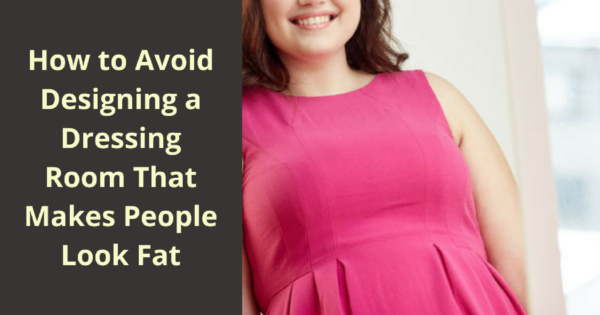As the owner or operator of a clothing retail store, the moment where a customer heads off to the fitting room with a selection of different items is an incredibly promising one. If a person likes a piece of clothing enough to go try it on, that means they are very seriously considering a purchase. However, it also means that what happens in the fitting room can make or break a sale for your store, and too often, what happens in the fitting room isn’t something the customer likes.
I’m talking about the way that a fitting room—between lighting, room color, room size, and mirror quality—can make a huge difference in how a person looks in the garments they are trying on. A recent Buzzfeed article and photo essay called “Here Is What The Same Person Looks Like In Dressing Rooms For 20 Different Stores” showed, with fascinating photographic detail, just how different a person wearing the same clothes can look under the conditions of various different retail store dressing rooms. The piece is a must-read for any clothing retail store owner.
The Essentials of Dressing Room Design
So what kind of effects can a fitting room have on a person trying on clothes? Sometimes, a combination of harsh lighting, bad mirrors, and weird fitting room color choices can be highly unflattering—resulting in customers not buying the clothes they try on because they didn’t like what they saw in the fitting room. Other times, fitting rooms can actually be too perfect, and can make a person look better in an outfit than they would out in the natural daylight of real life.
When my 5 foot, 105 pound friend who cries maybe twice a year is having a breakdown after leaving the Nordstrom dressing rooms – WE HAVE A PROBLEM.
It’s your lighting. It’s your carpeting. It’s the 360 degree mirror that makes it impossible to escape myself. I just don’t understand how such a prestigious, high-end department store could screw something up as big as the dressing rooms. – Emma Golden
As a retail store owner, your goal with your fitting rooms should be to strike a balance between these two extremes. You obviously don’t want a fitting room with unflattering lighting, because you need your customers to like what they see in the fitting room in order to make sales. However, you also don’t want people to think of your fitting room conditions as manipulative, which is something that could happen if customers are consistently finding that they don’t look as good in an outfit once they get home as they did in the fitting room.
In short, you want to strive for lighting and overall fitting room conditions that best mimic the natural light under which your customers will normally be wearing the clothes they purchase from your store.
The question is, what can your store do to improve fitting room conditions and provide shoppers with a more realistic idea of what they look like when trying on clothes? Alert Tech’s Marge Laney was recently featured in a Good Morning America segment that sought to answer this question.
Lighting
Probably the biggest factor in determining how your customers look in a fitting room mirror is the lighting. Overhead light—particularly harsh fluorescent lighting—can cast subtle shadows on a person’s body that accentuate wrinkles, bulges, and other not-so-flattering characteristics. With that said, dimmer lighting is also a poor dressing room choice, as it makes it more difficult for a customer to tell whether or not he or she looks good in an outfit.
Neutral white lighting that is bright and even can provide a more flattering impression without being seen as “false advertising.” Having multiple lights on the ceiling—and lighting panels down each side of the mirror—can provide the perfect level and quality of light to improve the fitting room experience, and won’t cast awkward, ugly shadows on your customer.
Mirrors
Bottom line, every retail store needs to invest in high-quality mirrors for its fitting rooms. Cheap mirrors are often warped, bent, or bowed, resulting in an unnatural (and almost always unflattering) reflection for your shoppers. More expensive mirrors made from higher-quality glass and materials, meanwhile, provide a much more natural and realistic look. It’s also a good idea to go for larger mirrors for fitting rooms, as smaller ones simply make it more difficult to get a full head-to-toe look at an outfit.
[xyz-ihs snippet=”MOFU-Fit-Happens-button”]
Color and Size
Just like a small mirror can make it difficult for shoppers to get a full view of their outfits, small and cramped fitting rooms can make it harder to get a good look at oneself in the mirror. In fact, overall fitting room design can play a big role in how customers perceive their appearance.
Color is a big factor, with certain brighter hues (oranges, pinks, etc.) sometimes conspiring with the light and mirrors to cast shoppers in an unnatural glow. Meanwhile, darker colors, like brown or black can add to the feeling of a dressing room as a dark and dingy place. More neutral colors, like white, light blue, or even a muted wallpaper pattern, can make the fitting room more attractive without messing with the lighting.
[Tweet “How to Avoid Designing a Dressing Room That Makes People Look Fat #fittingroom @alerttechinc”]
Conclusion
As you can see, there are a lot of different factors to consider in fitting room design, and since there is really no retail industry standard, every different store or chain more or less does their own thing. By keeping the above tips and pointers in mind, however, your store can beat the competition, provide shoppers with a better fitting room experience, and increase its rate of fitting-room-to-sale conversion.
[xyz-ihs snippet=”Fit-Happens-CTA”]

